My research
My research focuses on studies of X-ray binaries and related
objects. I have a few separate lines of research into X-ray
binaries and other black hole and neutron star research. I have been
especially involved in understanding the compact object populations of
globular clusters, and I have gotten involved in other aspects of globular
cluster research as a result of that interest.
What are X-ray binaries?
X-ray binaries are close systems which contain a black hole or a
neutron star and a more normal star. They must be close enough
that the compact star (i.e. the black hole or neutron star) can accrete
matter lost by the normal star.
Low mass X-ray binaries are those in which the normal star has a
relatively low mass, and the mass transfer occurs via Roche lobe
overflow, where part of the normal star enters the region where the
gravitational field of the compact star is stronger than that of the
normal star. The matter then spirals in through an accretion
disk, radiating away much of its gravitational energy as X-rays, and
also powering a jet which moves away from the system as speeds
comparable to the speed of light. The visualization of an X-ray
binary below was produced using Rob Hynes' binsim program to make a
computer-generated artistic impression.

Population studies of
X-ray binaries
My main goal from this line of research is to understand how X-ray
binaries form and evolve. One particular point of interest to me
is the role of globular clusters in producing X-ray binaries. It
is well known that there are many more X-ray binaries per unit stellar
mass in the globular clusters of the Milky Way, since 13 of the 150 or
so known bright X-ray binaries have been found in globular clusters,
while only about 0.1% of the stars in the Galaxy are in globular
clusters. It is generally thought that there are these extra
X-ray binaries because the neutron stars (and possibly black holes) in
globular clusters can capture new counterparts. That is, while
there is a finite lifetime for accreting for a compact object, because
it will eventually "eat" its entire mass donating companion, in
globular clusters, the stellar densities are high enough that various
types of stellar interactions will occur to create new close binary
systems which will undergo accretion. The major channels for
these processes are two body tidal capture, where an unbound pair of
stars becomes bound because some of the kinetic energy is dissipated in
tidal interactions with the normal star; and three-body exchange
interactions, where one star passes near a binary star system, and the
single star displaces one of the normal stars, but more complicated
interactions can happen as well.
Because the number of globular clusters is so small in the Milky Way
galaxy, it makes more sense to look at elliptical galaxies for this
work, as the ellipticals have large globular cluster systems.
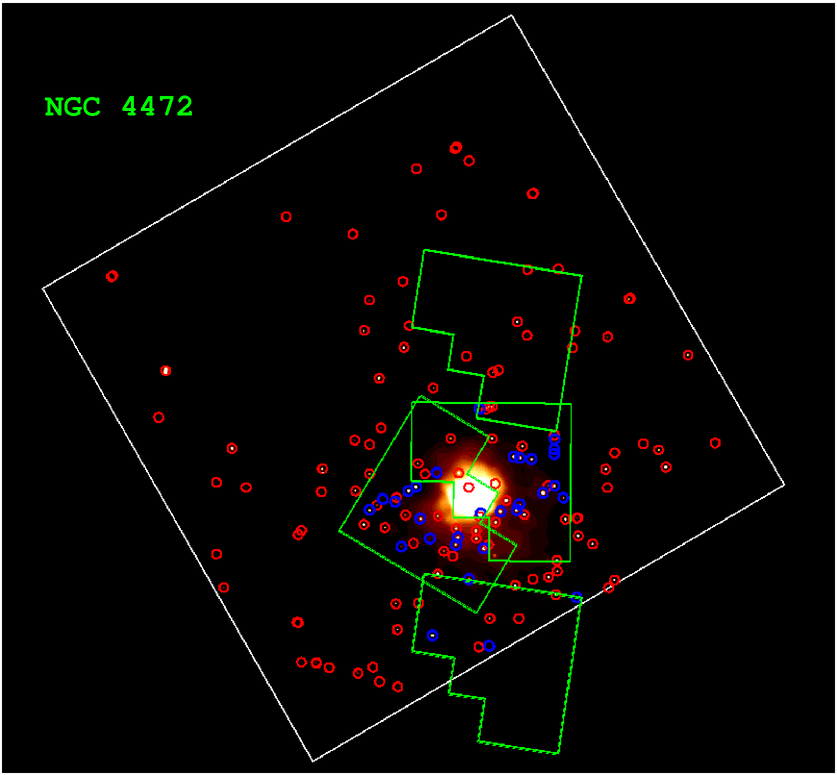
The image above is a Chandra X-ray observatory image of NGC 4472, one
of the brightest nearby elliptical galaxies. In the center, one
can see diffuse emission, which is hot gas in the galaxy. Toward
the outer parts, one can see points of emission, which are X-ray
binaries. The white box shows the Chandra field of view, while
the green boxes show the Hubble Space Telescope fields of view.
Red and blue circles have been added to guide the viewer to the X-ray
binaries. The blue circles show the X-ray binaries which are in
some of the roughly 1000 globular clusters detected in this galaxy.
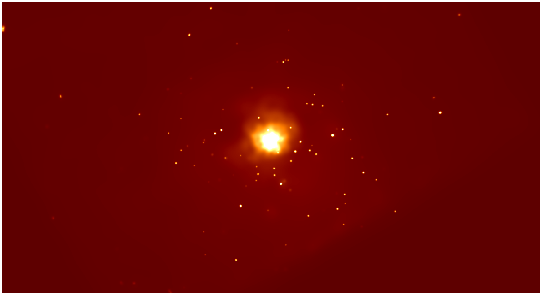
The image here is the same data, plotted with different contrast
levels, and without the circles identifying the individual sources.
In the process of studying this and other galaxies, we have make
several key discoveries. Perhaps the most intriguing is that the
metal rich globular clusters are substantially more likely to contain
X-ray binaries than the metal poor clusters.
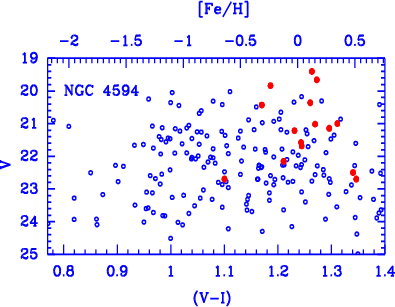
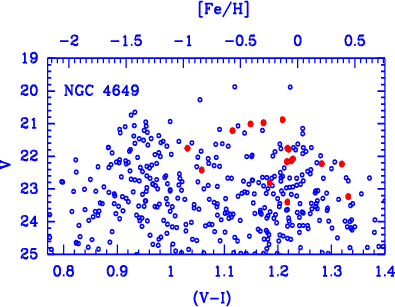
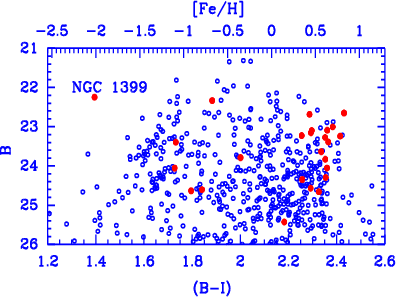
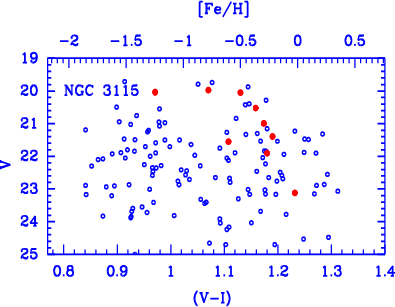
Here we have plotted the globular clusters in these galaxies with open
circles, and the ones with X-ray binaries with filled red
circles. Note that the bulk of the red circles appear to the
upper right, in the massive, metal rich globular clusters.
In the future, we hope to understand whether there are dependences of
the number of X-ray binaries on other key properties of the globular
clusters, such as their ages. At the present time, age does not
seem to be an important parameter, but the available data is not
strongly constraining.
The first globular
cluster black hole
We have recently made the discovery of the first clear example of a
black hole in a globular cluster. Historically, it's been known
that all of the bright X-ray sources in the Milky Way's globular
clusters are neutron stars, since all but one show thermonuclear bursts
from their sufaces, and there are good circumstantial pieces of
evidence to believe the other one is a neutron star, as well.
Therefore, to look for accreting black holes in globular clusters, one
needs to go to other galaxies. However, the problem then arises
that the resolution of X-ray telescopes is insufficient to separate
multiple sources in the core of a cluster - simply finding an X-ray
source which is too bright to be a neutron star is not enough to prove
that it must be a black hole.
To help solve this problem, we used the X-ray Multiple Mirror satellite
(XMM) and made a long exposure of the galaxy NGC 4472 (the same one
pictured above). Because XMM has a large collection area, it's
more sensitive to variability than Chandra. Finding strong
variability in a bright X-ray source proves that the X-rays come mostly
from a single source, because mutliple sources would not be likely to
vary together. Fortunately, we were successful, producing this
time series of X-ray intensities from a source at 4x1039
ergs/sec, about 20 times the maximum luminosity for a neutron star
under normal conditions.
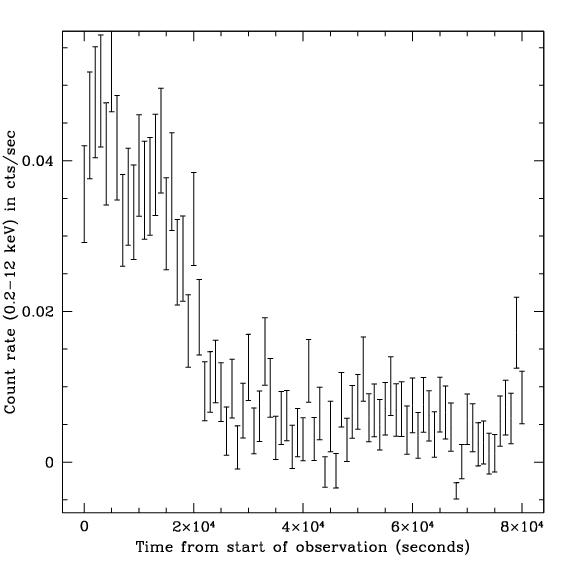
Searches for
intermediate mass black
holes
There is currently strong evidence in the Milky Way galaxy for black
holes which have masses of about 10 times that of the Sun. There
also seems to be a black hole at the center of nearly every galaxy,
with a mass of about 0.1% of the mass of that galaxy's bulge.
However, the bulges typically have masses of about 109 solar
masses,
meaning that these black holes are all at least a million or so solar
masses. How these black holes grow, and from what type of objects
their growth begins is currently a mystery in astrophysics. Do we
start with the same 10 solar mass black holes that we see in our
galaxy, and which can be produced in supernova explosions, and then
grow them by accreting gas? Or can we produce larger black holes
as seeds through some other method? The first generation of stars
are often suggested to be a candidate, as theoretical work indicates
that they may be much larger on average than the stars we see today,
and as a result, they might leave behind black holes of hundreds or
thousands of solar masses. Or black holes might merger with one
another to produce larger black holes.
A key to understanding all of this is to identify the intermediate mass
black holes - the black holes which are either in the process of
growing into million solar mass, or whose growth has been interrupted
for some reason. A variety of approaches have been suggested for
identifying these systems, mostly focused on either stellar dynamical
measurements designed to reveal the presence of a dark massive object,
or on finding strong X-ray emission from these objects. However,
the stellar dynamical techniques require very large densities of nearby
stars in order to provide an adequate sampling of the gravitational
potential (since the objects will not be in simple two body Keplerian
orbits). The searches for high luminosity sources require that
the black holes be in regions with large supplies of gas. Neither
is necessarily likely to be the case generically for these intermediate
mass black holes.
My work in this area has focused on finding more novel techniques for
identifying these intermediate mass black holes in other regions of
space. One such method is by looking for radio emission.
Nearly all (or perhaps truly all) accreting black holes produce radio
jets (see Rob Fender's web page for more details about this and about
possible exceptions to this rule). It has been found recently, in
papers led by Andrea Merloni and by Heino Falcke, that the ratio of
radio to X-ray emission is highest for the most massive black holes,
and for the black holes accreting at the lowest luminosities. Two
of the key places to search for intermediate mass black holes are in
the centers of globular clusters and the centers of dwarf galaxies, in
both of which cases there is not likely to be much gas present. I
and collaborators are working to identify good candidates for
intermediate mass black holes in these locations. Furthermore,
some theoretical models for the formation of galaxies suggest that
there should be large numbers of intermediate mass black holes in
interstellar space in our own galaxy. The upcoming LOFAR
instrument (standing for Low Frequency Array), will make deep radio
maps of the entire Northern hemisphere sky, and will aid greatly in
searching for such objects.
Other areas of interest
I have also done some work trying to connect the properties of
AGN and X-ray binaries, and trying to exploit novel statistical
techniques for studying the X-ray variability of X-ray binaries.
My
publications







